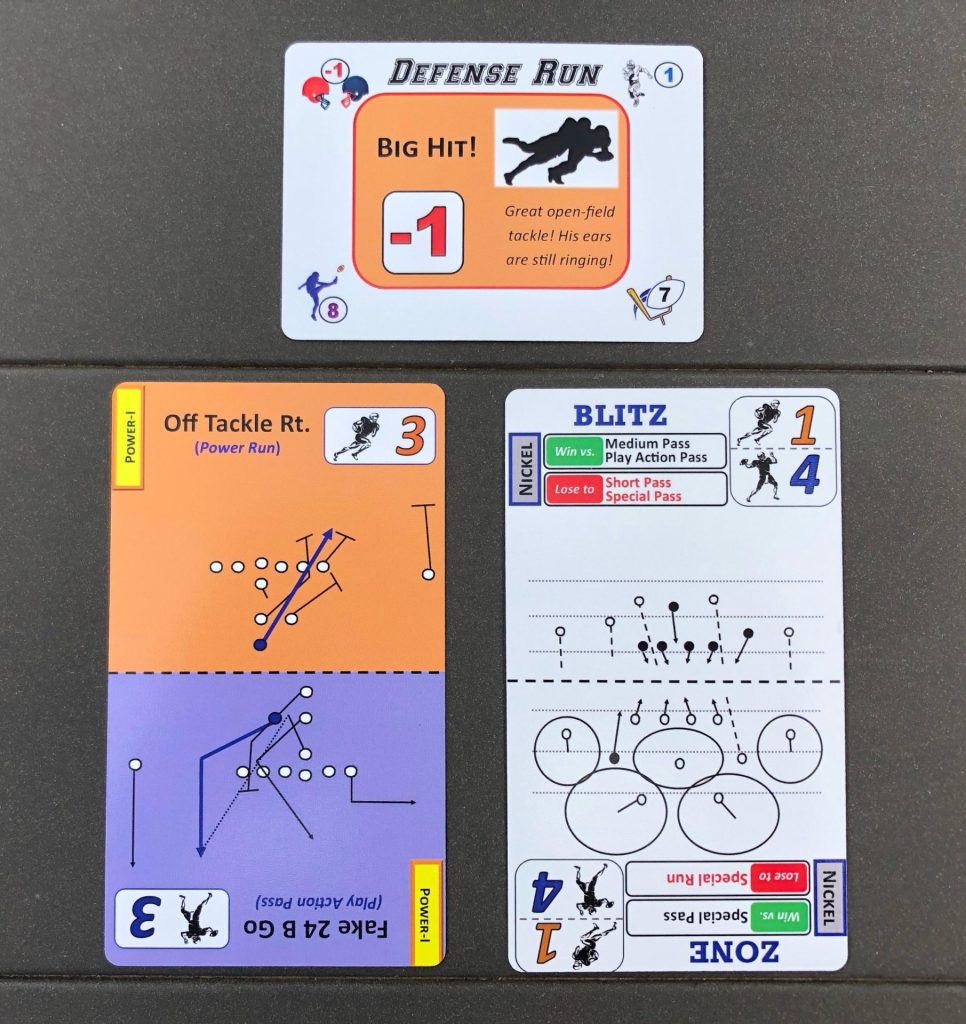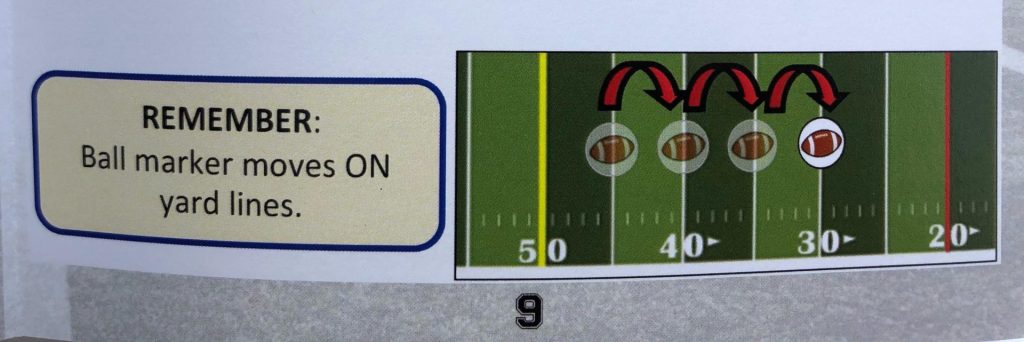Note: Meeple Mountain contributor Art Franz co-designed this game. However, all views expressed are my own.
Tabletop versions of real-world sports are a difficult prospect. There’s a balance to be struck between outright simulation full of crunchy details aimed for hardcore fans and more abstract representation focused on capturing the feel of the sport rather than the specifics.
American football presents a particularly thorny case. Football is ubiquitous in this country, permeating so much of American life that it’s the de facto national sport. (Sorry, baseball, but you’re extremely boring.) While fans of every level can appreciate the sport’s hard-hitting athleticism and unexpected swings of fate, it’s the strategic depth underlying every aspect of play that makes it such a phenomenon. Translating that gridiron greatness to the tabletop is incredibly challenging. The ideal tabletop football game needs to simultaneously be accessible and complex, tactical and strategic, visceral and cerebral all at the same time. Because that’s generally impossible, most games pick a side and stick with it.
Breakaway Football leans very heavily towards the simulation side of things. This is not designed for casual gamers, nor is it designed for casual football fans. If you’ve ever wondered what the difference is between a punt and a kickoff, turn back now. It’s about to get heavy.
Xs and Os
Explaining the rules to Breakaway Football is incredibly complex, yet the core is very simple. Two players face off as rival football teams. Each turn, the player with the ball plays a hidden Offense card and the defending player then plays a hidden Defense card. These cards are unique to the teams being played, allowing for different playstyles and matchups. Both cards are revealed, possibly modified by a Game Day card representing various unexpected events, and compared to determine the result of the play. Over a series of plays, the player on Offense attempts to move far enough to score. If they do OR can’t do so in the time allotted, the players switch roles and play continues. When the game ends, the player with the most points wins.

But of course, like American football, the devil lies in all the extra details that make the game so endlessly intriguing. The use of downs that drives the game’s tension. The slick scoring system that forces teams to consider whether three points in hand is better than a hypothetical six or seven. The endless strategizing around field position and managing the clock. All these facets of the sport (and many more) appear in Breakaway Football.
There are a few interesting twists to help the game run smoothly. For example, in Breakaway Football, the ball travels only on the 5- and 10-yard lines, with downs resetting at the 20- and 50-yard lines. This gives each drive a larger feel, rather than getting caught up in the minutiae of individual yards. Accordingly, the result of a play is scaled to these increments, so a gain of 15 yards translates to a gain of 3 here. To get that number, we have to look at the Offense and Defense cards.

Each Offense card features a base numerical value along with the general type of play it is (a Run or Pass) and then a further subdivision (for example, Inside Run or Play Action Pass). Each Defense card features two values, one for use against Run plays and the other for use against Passes. At baseline, the appropriate Defense value is subtracted from the Offense value to determine how far the ball moves.
However, every Defense card also includes a list of matchups indicating which types of plays that pattern is particularly strong or weak against. This allows the potential for Breakaways: particularly potent plays on either side of the ball. When the Defense is strong against the called play, they get a Defense Breakaway; conversely, when they’re weak against it, the Offense gets an Offense Breakaway. These explosive opportunities require careful strategizing, but they can change the course of a drive substantially.

The Game Day cards add the final ingredient to this competitive cocktail: after determining how the Offense and Defense cards stack up against each other, a Game Day card is flipped to reveal a Play Event representing the unexpected things that can happen during any given play. If the Play Event’s play type matches the play type called by the Offense, the listed event occurs; otherwise it is discarded. As an example, a Pick card representing an interception causes a turnover if the Offense called a Pass, but has no effect on a Run play.

The Game Day card also determines the outcome of a Breakaway. On a Defense Breakaway the defending player chooses EITHER the event listed on the Game Day card OR the Defense Breakaway value, which is typically either a zero or a negative number, meaning that the defense forces a loss of yardage. Offense Breakaways are more complicated: the player on Offense has a similar choice between the Game Day event or the Offense Breakaway value, but with the crucial caveat that they can keep flipping cards and adding onto their play until they get a card with a zero or turnover result on the Offense Breakaway value.
Rounding out Breakaway Football’s attempt to capture real-world football’s intricacy is the clock management system. Once an Offense card is played it’s discarded; Defense cards are instead returned to hand. At each change in possession, the newly-minted Offense player must discard down to match the opponent’s hand size. Whenever a player runs out of Offense cards, the quarter is over and both players pick up all their Offense cards. In this way, every quarter runs exactly 15 plays; however, the exact number of plays run by each team varies dramatically based on how well they maintain possession. Teams can also use their three timeouts per half to extend a drive. When a player uses a Timeout, the Offense player may take one play from the discard pile. This can be used aggressively to preserve a potential scoring opportunity or defensively to try and maintain time on the clock for a hypothetical change in possession.
Lastly, all the above gets filtered through the lens of each individual team’s unique ruleset and card distribution. The four teams included in the base game (with many more available through expansions) represent different playstyles based on real-life teams. The Maulers, for example, are a run-heavy team with limited passing ability that excels at clock management. This shines through in the large values on their run plays, the correspondingly low values on their pass plays, and most distinctly in their ability to discard an Offense card each time they gain a first down or score. While there isn’t any customization, there’s enough variety that every player can find a team that fits their preferred strategy.

The Ruling on the Field
When I first cracked open Breakaway Football, I was a little taken aback by its presentation. Not because the components are bad: they’re reasonably decent, though the board is a bit flimsier than I would like. No, what struck me was the graphic design. This is a very busy board and the multi-use cards pack a lot of information into a small space. As one example, each of a team’s 15 Offense and 10 Defense cards are double-ended, making them a little difficult to parse at first glance. This is particularly frustrating because of the clock management system, which forces players to discard cards whenever they get the ball. (Though it works mechanically, having a team shorten their playbook with every drive is a strange thematic disconnect. Worse than that it requires a long delay while players try to evaluate which cards are worth keeping.) More galling from a visual standpoint are the Game Day cards, with their central events and then four different values. It takes a while to learn which value is referenced and how it’s applied during any given situation, which makes the first game or two painfully slow.

Looming over these issues is the real problem: the rulebook. The rules rely heavily on the player’s pre-existing knowledge of football. If you don’t already understand the sport, you will absolutely not be able to learn this game. Those rules are also incomplete in quite a few places, relying on players to interpret the results. For example, it’s unclear when and how you can decline or challenge a penalty event. (Challenging a Game Day card’s Play Event allows the player to simply ignore it at the cost of one of their limited Challenge Flags.) By football logic, some penalties cannot be challenged. By the rules of the game you seem to be able to do so. At no point is it spelled out what declining a penalty means. With so many small rules to consider, figuring out these gaps can be frustrating.

Those are some major negatives, but the tradeoff here is in verisimilitude. This game is jam-packed with details and confusing rules because the sport itself is full of them. Once you learn how Breakaway Football works and become familiar with the different teams, it all starts to come together into a game that is not just football-themed but a miniaturized version of the sport. Everything, and I mean everything, has been considered and adapted for this game. From the first kickoff to the dying seconds of overtime the strategy doesn’t stop. The mind games around playcalling are exceptionally interesting, and when a clever read pays off in a Breakaway or a team comes up with a big play on third down, it’s hard not to cheer. The Game Day cards may feel a touch too random for some players, but on the flip side, they do a great job of simulating the unpredictability of football and ensuring that a more experienced player can’t run away with the victory. Every play of every drive brims with potential in a way that speaks to football’s enduring appeal.
Breakaway Football is a game that cries out to be played again and again. The various matchups between teams feel unique yet never feel unwinnable. Some of the lesser-used or optional rules, like the ability to shorten a punt, give players even more granular control over tactics. Short of actually managing individual players, there’s not much more I could imagine adding to the game that would make it feel more true to the real deal.
Breakaway Football can only be described as a messy masterpiece, a brilliant experience just slightly obscured by a few glaring flaws. I certainly wouldn’t recommend it to everyone, at least without a little more polish to help soften those rough edges. However, if you’re looking for a complex football game that lets you become a head coach from the comfort of your couch, you need to scoop up Breakaway Football before your next game day.











Add Comment